 |
|
 |
February 2012 |
 |
|
|
 |
Feature Article
|
 |
 |
Battery Evolution: Ensuring Batteries Meet the Safety Concerns of a Changing World
Rich Byczek, Technical Lead for Electric Vehicle and Energy Storage
Intertek
People depend on batteries for a number of reasons. Pacemakers and defibrillators, for instance, work inside the body to keep the heart pumping. Mobile handset batteries power communication, facilitating a global marketplace and a fast-paced economy. Automobile batteries make it possible to travel at will. As these products and a host of others are being redeveloped and refined and consumers demand more from their devices, batteries have to be able to satisfy ever-increasing market demands. ...read more
|
|
 |

|
| |
Sponsored Announcement |
 |
 Battery Power 2012 Call for Presentations Battery Power 2012 Call for Presentations
Battery Power 2012 is currently accepting abstracts for its tenth annual event, September 18-19 in Denver, Colorado.
With more than 400 attendees, the conference provides an excellent forum to discuss new developments in technology, market conditions and end-user requirements that are driving innovation, capabilities and features, application trends and performance improvements.
Attendees include top executives, technical managers and engineering professionals from original equipment manufacturers, system developers and integrators, dealers and component providers.
Speaking slots always fill up fast so it is imperative that you submit an abstract by the April 12th deadline. Click here for details on submitting an abstract.
|
 |
 |
| |
New Products |
| |
Microchip Launches 8-bit Microcontrollers with Integrated Configurable Logic in 6- to 20-pin Packages
The PIC10F(LF)32X and PIC1XF(LF)150X MCUs each feature new peripherals, including Configurable Logic Cells (CLCs), Complementary Waveform Generators (CWGs) and Numerically Controlled Oscillators (NCOs), enabling functionality that was not possible before with low pincount MCUs. These general-purpose MCUs enable designers to enhance the functionality, reduce design size, and decrease the cost and power consumption of products.
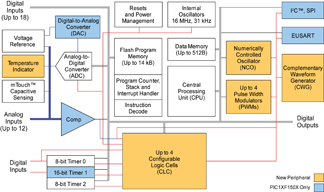 The CLC peripherals on the PIC10F(LF)32X and PIC1XF(LF)150X MCUs enable software control of combinational and sequential logic, which increases the on-chip interconnection of peripherals and I/Os, thereby reducing external components, saving code space and adding functionality. The CWG peripheral works with multiple peripherals to generate complementary waveforms with dead-band control and auto shutdown, which provides improved switching efficiencies. Additionally, the NCO peripheral enables linear frequency control and high resolution, which is required for applications such as lighting ballast, tone generation and other resonant control circuits. The MCUs also feature low power consumption, with currents of less than 30 µA/MHz in active mode, and less than 20 nA in sleep; as well as an on-chip 16 MHz internal oscillator, Analog-to-Digital Converter (ADC), and up to 4 Pulse-Width Modulation peripherals. An integrated temperature-indicator module enables low-cost temperature measurements. The CLC peripherals on the PIC10F(LF)32X and PIC1XF(LF)150X MCUs enable software control of combinational and sequential logic, which increases the on-chip interconnection of peripherals and I/Os, thereby reducing external components, saving code space and adding functionality. The CWG peripheral works with multiple peripherals to generate complementary waveforms with dead-band control and auto shutdown, which provides improved switching efficiencies. Additionally, the NCO peripheral enables linear frequency control and high resolution, which is required for applications such as lighting ballast, tone generation and other resonant control circuits. The MCUs also feature low power consumption, with currents of less than 30 µA/MHz in active mode, and less than 20 nA in sleep; as well as an on-chip 16 MHz internal oscillator, Analog-to-Digital Converter (ADC), and up to 4 Pulse-Width Modulation peripherals. An integrated temperature-indicator module enables low-cost temperature measurements.
To facilitate application development, the PICDEM Lab Development Kit (part # DM163045, $134.99) now includes samples of both the PIC10F322 and PIC16F1507 MCUs. Additionally, the F1 Evaluation Platform (part # DM164130-1, $39.99) is available for development with enhanced mid-range core 8-bit PIC MCUs, including the PIC1XF(LF)150X family. Also available is a free CLC Configuration Tool, to streamline the setup process of the CLC module by simulating the functionality of the registers and combinational logic in a graphical user interface (GUI).
The PIC10F(LF)320 and PIC10F(LF)322 MCUs are available in a 6-pin SOT-23 package, as well as 8-pin PDIP and 2 mm x 3 mm DFN packages. The PIC12F(LF)1501 MCU will be available in 8-pin PDIP, SOIC, MSOP and 2 mm x 3 mm DFN packages, and the PIC16F(LF)1503 MCU in 14-pin PDIP, SOIC and TSSOP packages, as well as a 3 mm x 3 mm QFN package. The PIC16F(LF)1507 MCU is available in 20-pin SSOP, PDIP, SOIC, and 4 mm x 4 mm QFN packages, as will the PIC16F(LF)1508/9 MCUs, when available. Pricing starts at $0.37 each, in 10,000-unit quantities.
Click here for more information.
|
Universal Power Group Launches Adventure Power Phantom Line of Lithium-Iron Phosphate Powersports Batteries
Universal Power Group, Inc. has launched the Adventure Power Phantom line of lithium-iron phosphate batteries for motorcycles and the powersports category. UPG also released a new strategic alliance with Shorai, Inc., a manufacturer of lithium iron-based powersports batteries, that will provide the technological expertise required for the development and production of the new Phantom line, which will be marketed by UPG. Under the terms of its agreement with Shorai, UPG will market a line of lithium iron phosphate-based batteries under the Phantom line, utilizing Shorai’s eXtreme-Rate LiFeP04 cell technology.
The Phantom line is the latest, high-performance addition to the Adventure Power series, an extensive line of batteries designed for motorcycles, scooters, ATVs, personal watercraft, snowmobiles and American V-Twins. The new lithium iron-batteries are designed to be a drop-in replacement for all OEM equipment and install in a matter of minutes. In addition, they are designed, engineered and tested in accordance with JASA’s JIS D 5302, the internationally accepted standard for powersports batteries.
Maxim's Smallest USB Battery Charger Detectors Provide a Virtually Universal Charging Experience
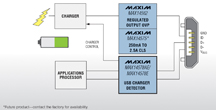 Maxim Integrated Products, Inc. has announced the MAX14578E/MAX14578AE, USB battery charger detectors that are compliant with the USB Battery Charging Specification. These devices detect USB standard downstream ports (SDPs), USB charging downstream ports (CDPs) or dedicated charger ports (DCPs), in addition to proprietary charger adapters from Apple and Sony. When a charging port is detected, the MAX14578E/MAX14578AE will control an external lithium-ion (Li+) battery charger controller to optimize charge time and charging efficiency. Maxim Integrated Products, Inc. has announced the MAX14578E/MAX14578AE, USB battery charger detectors that are compliant with the USB Battery Charging Specification. These devices detect USB standard downstream ports (SDPs), USB charging downstream ports (CDPs) or dedicated charger ports (DCPs), in addition to proprietary charger adapters from Apple and Sony. When a charging port is detected, the MAX14578E/MAX14578AE will control an external lithium-ion (Li+) battery charger controller to optimize charge time and charging efficiency.
By supporting a broad range of USB chargers, the MAX14578E/MAX14578AE offer consumers a "virtually universal" charging experience. Manufacturers also can now ship equipment without including power adapters, so they simplify their manufacturing supply chain while improving their green credentials.
An on-chip LDO provides a 5.3 V output, which can be used to power a USB transceiver. In addition, ESD protection on the USB data pins is extended up to +/-15 kV (Human Body Model) and +/-8 kV IEC 61000-4-2 Contact Discharge. These features substantially reduce system complexity, component cost and board space for today's highly integrated consumer devices.
The MAX14578E/MAX14578AE are available in a 12-bump, 0.4 mm pitch, 1.3 mm by 1.68 mm WLP package for space-critical applications, and in a 16-pin TQFN package for ease of manufacturing. They operate over the -40°C to 85°C extended temperature range.
C&D Technologies Releases TEL12-145FW Product
 C&D Technologies, Inc. has announced that the TEL12-145FW product, a valve regulated lead acid (VRLA) battery is now available to meet customer requirements. The TEL12-145FW is a product that supports the specifications of wireless operators, wireless infrastructure and wireline carriers as well as original equipment manufacturers for backup of telecom battery applications. C&D Technologies, Inc. has announced that the TEL12-145FW product, a valve regulated lead acid (VRLA) battery is now available to meet customer requirements. The TEL12-145FW is a product that supports the specifications of wireless operators, wireless infrastructure and wireline carriers as well as original equipment manufacturers for backup of telecom battery applications.
“The TEL12-145FW is an important addition to C&D’s True Front Access product line and meets the electrical performance and geometric space constraints for most ALU applications that are currently being deployed” said Jay Frankhouser, C&D Technologies’ telecom product manager.
The TEL12-145FW features true front terminal access to support ease of installation as well as ease of maintenance by the provider. The product size permits 145 amp-hour performance to 1.75 VPC at 77F nominal rating, which meets the requirements of most float service telecom applications. C&D’s TEL12-145FW provides a 10 year float life while meeting UL94-VO flame retardancy, UL (vent) and non-spillable industry specifications.
TYLT Introduces the PowerPlant Portable Back-Up Charger
TYLT has released the PowerPlant, a portable back-up charger with unique built-in Flex charging arm. The PowerPlant has a built-in battery that can provide nearly two full charges to most smartphones. The built-in Flex charging arm with Micro-USB or Apple 30-pin connector version means cables can be left at home while on the go. Designed for high-demand power users, the TYLT PowerPlant can rapidly charge one mobile device or simultaneously charge two mobile devices at the same time. Convenient LEDs indicate the remaining battery capacity.
The TYLT PowerPlant’s 2.1 amp circuit will rapidly charge today’s smartphones and most tablets as well. With a fully-charged 5,200 mAh lithium-ion battery, it can provide a smartphone with two full charges or two smartphones with up to one full charge each. The PowerPlant automatically starts charging when a mobile device is plugged in. It automatic shuts off to help ensure conservation of valuable battery life, so that energy is saved and available for when need. The Powerplant can be recharged by plugging any Micro-USB charger into it, whether it’s at home or in the car.
2.5 A CurrentPath Charger IC Enables Safe, Ultrafast Charging in Smartphones and Tablets with Programmable Flexibility
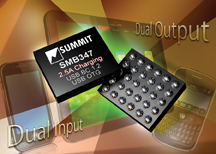 Summit Microelectronics has expanded its fourth-generation family of programmable Li-Ion battery charger integrated circuits (ICs) with the introduction of two new products. The SMB346 and SMB347 deliver up to 2.5 A charge/system current with dual input/dual output CurrentPath technology for operation with a dead or missing battery. Dual inputs accept both USB and AC/DC with automatic selection and support for all battery charging standards: USB 2.0 specification, USB on-the-go supplement, USB battery charging specification 1.2, IEEE1725 standard, Chinese USB charging specification, and others. Furthermore, the SMB346 and SMB347 are the only battery charger ICs with CurrentPath to detect the input source type (USB host/hub/charger, AC/DC) and automatically optimize operation for the fastest and safest battery charging. Summit Microelectronics has expanded its fourth-generation family of programmable Li-Ion battery charger integrated circuits (ICs) with the introduction of two new products. The SMB346 and SMB347 deliver up to 2.5 A charge/system current with dual input/dual output CurrentPath technology for operation with a dead or missing battery. Dual inputs accept both USB and AC/DC with automatic selection and support for all battery charging standards: USB 2.0 specification, USB on-the-go supplement, USB battery charging specification 1.2, IEEE1725 standard, Chinese USB charging specification, and others. Furthermore, the SMB346 and SMB347 are the only battery charger ICs with CurrentPath to detect the input source type (USB host/hub/charger, AC/DC) and automatically optimize operation for the fastest and safest battery charging.
The SMB346 and SMB347 are based on a 3 MHz, switch-mode DC-DC architecture, with minimal external components, which allows for more than 90 percent efficient conversion and compact solution size. The devices enable fast charging due to higher charge currents, while reduced thermal dissipation improves user comfort, system reliability and Green operation. Furthermore, Summit’s proprietary TurboCharge patent-pending technology enables high charge current, even from relatively low-power sources. As consumer devices continue to employ larger batteries, the SMB346 and SMB347 reduce charge time for consumer convenience.
The SMB346 and SMB347 are well suited for a wide range of portable devices such as smartphones, tablets, digital still cameras, digital camcorders, wireless routers, portable media/MP3 players (PMP), portable GPS navigation equipment and portable game consoles/controllers. The features and integration of the SMB346 and SMB347 make them well suited for portable devices that utilize high capacity batteries, for example, desire short charging time and feature very compact industrial designs. The SMB346 and SMB347 operate with an input range from 3.7 V to 6.2 V input and safely withstand continuous input over-voltage up to 20 V (non-operating), while protecting downstream circuitry.
The SMB346 and SMB347 are offered in a 2.46 mm by 2.96 mm, 30-ball, lead-free chip-scale (CSP) packages. Both products have an operating temperature range of -30°C to 85°C. Available now in production quantities, the SMB346 is priced at $1.27 and the SMB347 is priced at $1.36, each in quantities of 10,000 units.
Nichicon Develops 50 kW Quick Charger for EVs
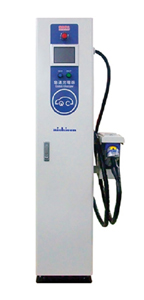 Nichicon Corp. has released a small and light quick charger for EVs (electric vehicles). This 50 kW capacity model is certified for the CHAdeMO system and expands the company’s lineup of quick chargers for EVs. By utilizing its technology for OBCs (on board chargers) for EVs and standardizing the main components, Nichicon has developed a 50 kW quick charger that is approximately 60 percent smaller and 50 percent lighter than its current model. Nichicon Corp. has released a small and light quick charger for EVs (electric vehicles). This 50 kW capacity model is certified for the CHAdeMO system and expands the company’s lineup of quick chargers for EVs. By utilizing its technology for OBCs (on board chargers) for EVs and standardizing the main components, Nichicon has developed a 50 kW quick charger that is approximately 60 percent smaller and 50 percent lighter than its current model.
With issues such as global warming raising the environmental awareness of people around the world, countries are working in earnest to reduce their carbon emissions. Nichicon has been supplying OBCs (with a DC/DC converter) for the Mitsubishi i-MiEV and the Nissan EV LEAF since the release of these two electric vehicles. Besides OBCs, Nichicon has also been helping spread the use of EVs by developing and mass-producing quick charging systems for vehicles.
This 50-kW model expands Nichicon’s lineup of high-capacity quick chargers. Like the world’s smallest and lightest 20-kW and 30-kW quick chargers for EVs, which Nichicon released on August 24, 2011, this model was made to be an ultra-compact quick charger. Nichicon has achieved a thin 50-kW EV quick charger: this latest model measures the same width and height (350 mm by 1,565 mm) as the 20-kW and 30-kW models.
The most remarkable point of this newly developed quick charger is that it occupies approximately 60 percent less space and weighs about 50 percent less than the current model. This saves the customer cost and effort in installing this system. And the quick charger’s thin profile makes possible a greater range of installation locations. Nichicon has also made the most of its technological expertise in OBCs to develop a modularized charger that boasts high reliability and high efficiency, features that will help hasten the spread of the charging infrastructure for EVs.
|
| |
Industry News |
| |
NEMA Welcomes Congressional Passage of Provision on Lithium Battery Air Shipments
NEMA, the association of electrical equipment and medical imaging manufacturers, welcomed the passage by the US Senate of legislation directing the US Department of Transportation (DOT) to ensure that most US regulations governing air shipment of lithium batteries are harmonized with standards written by the International Civil Aviation Organization (ICAO). The legislation also covers products that contain or are packed with lithium ion or lithium metal batteries.
On February 6th, the Senate approved the conference report for HR 658, the Federal Aviation Administration (FAA) Modernization and Reform Act, in a bipartisan 75-20 vote. The House approved the bill on February 3rd by a 248-169 vote. The House first approved legislation containing the provision on April 1st, 2011.
NEMA represents the leading US manufacturers of lithium metal batteries as well as many electroindustry companies that use lithium ion and lithium metal batteries in their products and equipment. NEMA is participating in ICAO meetings this week to determine if more stringent global rules are needed for lithium battery shipments on aircraft.
Specifically, the legislation requires that DOT agencies, including FAA and the Pipeline and Hazardous Materials Safety Administration, may not issue or enforce any regulation or other requirement regarding the transportation by aircraft of lithium metal cells or batteries or lithium ion cells or batteries, whether transported separately or packed with or contained in equipment, if the requirement is more stringent than the requirements of the ICAO Technical Instructions for the Safe Transport of Dangerous Goods by Air.
One exception from this requirement is the maintenance of the US prohibition since 2004 of air shipment of lithium metal cells and batteries on passenger aircraft leaving, entering or within the US or operated by a US carrier. A second exception allows the Secretary of Transportation to issue and enforce an emergency regulation that is more stringent than the ICAO requirements if that regulation addresses deficiencies referenced in a credible report of a safety incident that demonstrates lithium batteries or equipment transported in accordance with the ICAO standards substantially contributed to the start or spread a fire onboard an aircraft. After one year, the Secretary may convert the emergency rules into a permanent regulation under certain conditions.
Research and Markets: New Electrode Materials for Lithium Ion Batteries - 2012
Research and Markets has announced the addition of the "New Electrode Materials for Lithium Ion Batteries - 2012" report to their offering. Lithium ion batteries have increasingly become the workhorse power source for the consumer electronics and power tool market and they are finding new applications all the time. For example, some firms are developing lithium ion batteries for the electric vehicle (EV) market, while others seem them as a better bet than the more traditional chemical storage batteries currently used in smart electricity grids.
Within the consumer electronics and power tool sector, the market is looking for longer times between charges and quicker charging from lithium ion batteries and these performance measures will be key competitive factors going forward among the various kinds of lithium ion batteries being deployed. Elsewhere other measures, such as the cost of energy storage, will determine how well lithium ion batteries will do in sectors such as EV and smart grids.
Most of these critical factors will ultimately be determined by the materials that are chose for lithium ion batteries; especially the electrode materials used. This report examines the commercial implications of the newer materials that are being put forward for electrode materials. As the table of contents below indicates, the materials that we have covered in this report include nanostructured carbon and silicon, titanates, vanadium oxides, mixed metal oxides and a variety of lithium compounds.
This report explains the emerging requirements for battery performance in each of the main application sectors for lithium ion batteries and then shows how these translate into demand for novel electrode materials. It also analyzes the market strategies of major materials and battery firms active in this space. The report also provides the eight-year forecasts by application and material type.
Micro Power Receives UL 2054 Certification and CE Mark for IronWorks Iron-Phosphate Battery
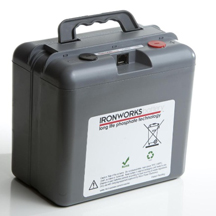 Micro Power Electronics, Inc., a subsidiary of Electrochem Solutions, Inc., has announced UL 2054 Certification and CE Mark for the IronWorks battery, a patent-pending Iron-Phosphate battery solution, which serves as a drop-in replacement for Sealed Lead Acid (SLA) batteries. Micro Power Electronics, Inc., a subsidiary of Electrochem Solutions, Inc., has announced UL 2054 Certification and CE Mark for the IronWorks battery, a patent-pending Iron-Phosphate battery solution, which serves as a drop-in replacement for Sealed Lead Acid (SLA) batteries.
Manufacturers of mobile equipment can now achieve lighter weight, longer runtime and longer cycle life with the standard U1 format Lithium Iron-Phosphate battery. IronWorks is a 12 Volt, 44 Ah Lithium Iron-Phosphate battery with Smart Battery 1.1 compliant SMBus interface for delivering state-of-charge information. IronWorks provides equipment manufacturers with a drop-in replacement for Sealed Lead Acid (SLA) batteries, at a fraction of the weight and with exceptional cycle life.
UL 2054 is the safety standard for household and commercial batteries. Compliance with this standard reduces the battery-related risk of fire or explosion during use, and reduces the risk of injury when batteries are removed from a product to be stored, transported or discarded. The UL 2054 certification enables mobile equipment manufacturers to declare compliance with IEC 60601-1, the general safety and essential performance standard for medical electrical equipment, for their mobile or portable equipment.
IronWorks also passed all tests and requirements to receive the CE Mark, which enables IronWorks to be sold in the European Community (EC). By qualifying IronWorks for the CE Mark, Micro Power ensures that IronWorks complies with all the requirements of the applicable EC directives.
GS Battery Expands Engineering Test Lab Capabilities
GS Battery (USA) Inc., has completed the initial phase of enhancements to its in-house engineering test lab. Located at the GS Battery headquarters in Roswell, Ga., the test lab internally supports quality system requirements while externally supporting customers' testing and product performance needs.
GSB has the capability to perform testing on a wide range of cell chemistries and battery types from 1 Ah up to 3,000 Ah capacities. Multi-channel test equipment, environmental chambers, and life cycle testing circuits are some of the recent additions. These enhancements, when combined with existing testing equipment, expand the range and quantity of products which can be analyzed in-house.
EnerG2 Opens New Manufacturing Facility
EnerG2, a Seattle-based company manufacturing advanced nano-structured materials for next-generation energy storage applications, announced the commencement of production at its energy storage materials plant in Albany, Oregon.
The Albany facility is the first manufacturing plant dedicated to the commercial-scale production of engineered carbon material. These materials are destined for use in high-performance energy storage applications. The initial phase of operations, beginning today, will ultimately require a large-scale local manufacturing workforce that is expected to expand with company’s portfolio of products.
In August of 2009, the US Department of Energy awarded EnerG2 $21.3 million to partially fund this facility. Since then, EnerG2 has been working with the Albany community, investors and highly skilled craftspeople to bring the factory from vision to design to high tech reality.
EnerG2’s Albany operations will leverage the company’s proprietary Carbon Technology Platform (CTP) to produce engineered high-purity carbon materials for a wide range of energy storage applications. The CTP rapidly advances the speed with which materials technologies are developed and manufactured for these applications. The CTP is both technology- and market-neutral, creating an unprecedented and valuable flexibility across a portfolio of energy storage applications.
EnerG2 currently works with more than 60 companies across the globe focused on energy storage application development. These device manufacturers will benefit from the CTP through increased material performance in existing storage applications, as well as the capacity to quickly develop and deploy advanced materials into a range of future energy storage solutions.
|
| |

|
 |
Event Listings |
 |
 |
 MicroManufacturing and NanoManufacturing MicroManufacturing and NanoManufacturing
March 28-29, 2012
Boston, Massachusetts
The MicroManufacturing Conference presentations discuss how micromanufacturing can improve part quality and lower production costs, sharing real examples that not only illustrate how to use the technologies, but also what not to do. The NanoManufacturing Conference sessions cover a broad range of topics including, metrology because “if you can’t measure it, you can’t make it,” nanostructure manufacturing techniques, the future applications of graphene in every day products, occupational and environmental health and safety concerns and antimicrobial technologies for medical devices. Network with experts and peers, have specific problems solved and find solution vendors for nearly every micro and nanomanufacturing challenge.
 SAE 2012 Powertrain Electric Motors Symposium for Electric & Hybrid Vehicles SAE 2012 Powertrain Electric Motors Symposium for Electric & Hybrid Vehicles
April 23
Detroit, Mich.
Join technology leaders at the SAE 2012 Powertrain Electric Motors Symposium for Electric & Hybrid Vehicles, on April 23 in Detroit, Michigan. This one-day symposium promises to provide a comprehensive overview on the latest global innovations in the vehicle powertrain electric traction motor industry. It will give insight on how fast the major players are moving and how this affects the world marketplace. The program will address market growth projections, requirements, and cost structures for three varieties of electric traction motors: permanent magnet motors, induction motors, and switch reluctance motors. This year's symposium will feature expanded coverage of rare earth metals, and, for the first time, presentations on testing and simulation.
 SAE 2012 WORLD CONGRESS SAE 2012 WORLD CONGRESS
April 24-26
Detroit, Mich.
The SAE 2012 World Congress theme, Get Connected, represents the new and diverse connections that will drive significant advancements in the auto industry of tomorrow. Not only does the theme symbolize literal connections, such as those between vehicles, infrastructure, the Internet, and the nation's electrical grid, but also demonstrates the most fundamental of connections; the connections and relationships between engineers who are developing the next generation vehicle technology. A must-attend for the automotive engineering community, this event represents an unparalleled opportunity to explore new technology through both technical sessions and the Innovators Only Exhibition.
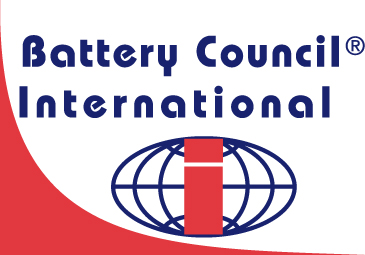 Don’t miss the world’s leading lead-acid battery event of 2012 • Every Encounter is an Opportunity Don’t miss the world’s leading lead-acid battery event of 2012 • Every Encounter is an Opportunity
Battery Council International’s 124th Convention & Power Mart Trade Fair
April 29 – May 2, 2012
Talking Stick Resort
Scottsdale, Arizona
A coffee break, an evening gathering, a committee presentation. Don’t miss the opportunity to meet the industry’s key players in one setting. BCI represents 250 worldwide members involved in all aspects of the lead-acid battery life cycle, from manufacturers and recyclers, marketers and retailers, to suppliers of raw materials and equipment, and industry consultants.
Reserve your place today!
Visit www.batterycouncil.org for online registration and updates on housing, speakers and exhibitors.
 International CTIA WIRELESS 2012 Conference & Exposition International CTIA WIRELESS 2012 Conference & Exposition
May 7 & 8-10, 2012
Ernest N. Morial Convention Center | New Orleans, Louisiana
There is no doubt the world is mobile – but how you embrace this movement to uncover new opportunities, connect with existing customers and partners, and explore new markets, can make all the difference to your business and your bottom-line.
CTIA is All Things Mobile. Now with new dates in May, International CTIA WIRELESS® is even better positioned to meet the needs of the global wireless marketplace. This bold move is more than a change of dates. It is the best opportunity to create a more personalized, powerful experience at the one place for carrier services, enterprise, communications, apps, content and social networking.
Register Now! www.ctiashows.com
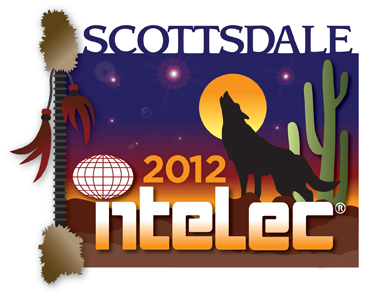 INTELEC 2012, Call for Papers INTELEC 2012, Call for Papers
INTELEC 2012 , the International Telecommunications Energy Conference, will be held between September 30 and October 4, 2012 at the Talking Stick Resort and Conference Center in Sunny Scottsdale, Arizona. The conference theme is “Star gazing in the desert: What keeps power people up at night?”
For more information on INTELEC please see www.intelec.org
Accepted papers will be included in the conference program and proceedings.
Please submit your 500 word to 1500 word digest on line by March 16, 2012 at http://submissions.miracd.com/intelec2012 on the following topics:
- Power systems for Communications and Data Centers
- Power Electronics circuits
- Energy Storage systems
- Power Sources
- Communications equipment Environment
- Powering broadband, 4G, WIMAX and wireless power transfer
|
 |
 |
|
 |
 |
|
 |
| |
Contact Us |
|
| |
Submit editorial content to Shannon Given at 608-351-9245
For advertising information contact Jeremy Fleming at 800-803-9488 X121
Webcom Communications • 7355 E. Orchard Road, Suite 100; Greenwood Village, CO 80111
Phone: 800-803-9488 • Fax: 720-528-3771 • www.infowebcom.com |
|
| |
© 2012 Webcom Communications Corp. |
|
|
|
|
|
|